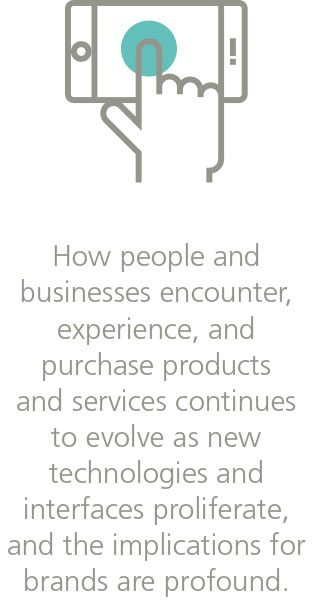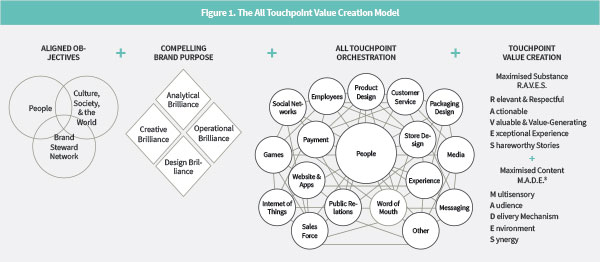By Yoram (Jerry) Wind and Catharine Hays, with Alexa de los Reyes
The fundamental relationships among brands, media, and people are being transformed at an unprecedented rate, necessitating a new definition of customer relationships. This article offers specific and practical guidelines for brands to understand, develop, and improve all points of interaction with people by adopting new mindsets and approaches.
How do most brands view people today? As masses of consumers categorised by purchasing power? Potential customers to be wooed, flattered, and fleeced? Or maybe as participants in a mutually beneficial symbiosis?
While that last one may sound a bit far-fetched, it is clear that the fundamental relationships among brands, media, customers, employees, and other key stakeholders are being transformed at an unprecedented rate. How people and businesses encounter, experience, and purchase products and services continues to evolve as new technologies and interfaces proliferate, and the implications for brands are profound. The role and empowerment of “customers” are also transforming, and there is nothing riskier than choosing to operate as though nothing has changed.
For the Wharton Future of Advertising Program’s (WFoA) Advertising 2020 project, over 200 thought leaders from around the world and across disciplines point the way to a new paradigm of customer relationships, which is expanded to include every point of interaction between people and brands, no matter where, when, or how the interaction occurs. The shift requires not only a change in perspective but also a transformation that has implications at every level throughout an organisation.
[ms-protect-content id=”9932″]
A New Mental Model for Customer Relationship Management
Fundamental to this transformation is the mindset that “consumers” are actually people. They – also known as you, me, all of us – deserve and demand respect. We are empowered to act when brands and their messages cross the line, as the fierce debates about ad blocking demonstrate. This shift in the balance of power has many brands feeling disoriented and uncertain. Fortunately, the WFoA has developed a model of new mindsets and approaches based on the insights and contributions to the Advertising 2020 project and termed the All Touchpoint Value Creation Model (ATVC). The model provides guidelines for building two-way and mutually beneficial customer relationships.
Challenging the mental model of CRM, or “customer relationship management,” is a key part of this transformation. For the future, CRM ought to become CMR, or “customer managed relationships”. CRM is used primarily to collect and analyse data about customers so the company can design messages to reach and manage them. CMR, on the other hand, empowers people to manage their own relationships with the brand and its competitors. This approach has far-reaching implications for how a brand encounters, interacts with, and develops relationships with people. Organizations using a product-led growth (plg) motionare focused on the customer journey that occurs within the product itself, and thereby turn to plg crm tools to monitor behaviors and adjust accordingly.
When the customer manages the relationship it becomes tailored to the distinctive nature of individuals and relies on their choice: whether to have a relationship with a brand and to what extent. Think for example of SABRE, a technology platform developed by American Airlines in the 1950s that empowered travel agents to access information from every airline, not just American. The platform, an effective tool that solved a genuine need, eventually became more valuable than the airline itself and is the foundation for many of today’s travel sites, such as Travelocity.
The All Touchpoint Value Creation Model
The ATVC model captures the key elements of this desired future of multi-win outcomes and is summarised as:
The ongoing, synergistic orchestration of All Touchpoint Value creation among an enterprise, the people in its network, the people it seeks to reach and serve, and the societies and cultures in which it exists and has responsibility.
The first and fundamental element of the ATVC model is aligned objectives among the key players. This is probably the most essential shift necessary for the future of customer relationships. Rather than thinking about “consumers”, which implies a one-sided and limited conception of people, the ATVC model is centred around creating mutually beneficial relationships among the brand steward network, people, and culture, society, and the world. When business objectives are aligned with the objectives of each of these parties, more positive multi-win outcomes for both short and long-term impact are more achievable.
The second element of the model is a brand purpose that is defined and supported by the entire organisation, combining analytical, operational, creative, and design brilliance. A compelling, unifying brand purpose that resonates with people on a deeper level than “sales” serves as a north star for both external and internal brand perception, which are equally important for authentic and sustainable brand building. Also, research shows that purpose-driven companies outperform their peers with better client retention, better margins, stronger loyalty, and higher valuations.1
Third, the brand purpose is orchestrated across all touchpoints – every point of interaction between people and a brand, such as product design, package design, and customer service. This requires a wholesale change in mindset across and throughout the organisation, including bridging some of the most persistent internal and external silos.
Fourth, each touchpoint is designed for both content and context following the R.A.V.E.S. and M.A.D.E.S guidelines, described in detail below. These guidelines take into account and take advantage of the dramatic changes in our social and technological environments, while being grounded in a deeper understanding and appreciation of our hearts and minds. (See Figure 1 above)
Below we explore how successful brands are rethinking the significance, nature, and scope of customer relationships, using the All Touchpoint Value Creation model as a guide. The first step towards implementing the proposed changes is to challenge mental models. Of course not all current mental models are wrong nor need to be changed, but all should be challenged to ensure that the mindsets we have are by choice and based on new and future realities. As Albert Einstein famously asserted, “Without changing our patterns of thought, we will not be able to solve the problems we created with our current patterns of thought.”
Next, after implementing the key elements of the model, it is essential to adopt a culture of adaptive experimentation to demonstrate the impact of the brand’s initiatives, learn how to be most effective, and ignite creativity and risk-taking.
 1. Aligned Objectives for Win-Win-Win Outcomes
1. Aligned Objectives for Win-Win-Win Outcomes
For brands looking to generate a network of customers, dedicated employees, and supporters, what we are calling “brand stewards”, the following qualities are required: a clear and consistent purpose in the world and in people’s lives; authenticity and authority; trust and transparency. A clear and consistent purpose is essential to attract and engage talented employees and collaborators as well as customers. When a brand acts on an authentic purpose, it naturally generates trust, which is more important than ever as people become increasingly skeptical and distrustful of superficial advertising. Finally, transparency is a given today, whether desired or not, so it might as well be part of the business plan.
Patagonia provides a powerful example of how brands with purpose and aligned objectives create multi-win scenarios. The company launched its “Don’t Buy This Jacket” campaign in 2011, encouraging customers to reuse and recycle their Patagonia gear rather than buying new products. The ideals of durability, conservation, eco-friendliness, and respect are key to the brand’s purpose. After nine months, Patagonia had a one-third increase in sales and opened 14 new stores;2 a perfect example of multi-win outcomes for the entire brand steward network. More recently REI initiated a similar strategy in 2015 with their “#OptOutside” campaign, announcing that all stores would be closed on the busiest shopping day of the year and encouraging people to spend time outdoors instead. As this effort is in line with their core company values, it resonates rather than coming across as a gimmick. They earned a 26 percent hike in online traffic and won several media awards including the Titanium Grand Prix at Cannes.3
2. Converging Analytic, Creative, Design and Operational Brilliance to Bring a Compelling, Unifying Brand Purpose to Life
As discussed above, a unifying purpose is essential for establishing the role of brands in people’s lives and in the world. In order to identify and bring this purpose to life over time, all functions of the organisation must work together, recognising that creative ideas can come from everywhere – from brand managers, technologists, creatives, or anyone in the organisation.
Many brands today provide successful examples of analysts, creatives, designers, and operational experts working hand in glove to design and unleash exceptional experiences in support of a compelling brand purpose. The brand purpose of SAP, for example – empowering their customers to improve the economy, the environment, and society through technology – is integral to their whole business model. The technologies and platforms developed by SAP are used around the world in creative initiatives to tackle pressing environmental and societal problems such as flooding in Buenos Aires, improving energy efficiency in the Netherlands, and personalising cancer care.
3. Orchestrating Value Creation across All Touchpoints
The increasingly sophisticated and nuanced ways to reach and interact with customers requires that brands move past the severe limitations of the “media mix” approach and consider creating platforms for two-way value creation. Connected transportation, homes, appliances, health, pets, gardens, education, waste, clothes, leisure…all are potential value creation touchpoints, and importantly, all are platforms for meaningful interaction, not one-way messaging.
A great example of a brand doing all touchpoint orchestration well is Bonobos, the men’s clothing company launched in 2007 as an exclusively online company. They have become renowned for their intense dedication to customer service, which extends throughout their customer service, store design, shopping experience, sales policies, packaging, social media, and organisational culture. In addition to pioneering exceptional e-commerce, in fall 2011 they launched brick-and-mortar stores called Guideshops that enable customers to request fitting appointments online to try out products with personalised service. In 2015, Bonobos hired a Chief People Officer, to move the emphasis of the HR role from “benefits” to “culture and people”. The depth and breadth of Bonobos’ dedication to its customers as well as its employees has bred impressive success.
4. Touchpoint Value Creation Guidelines: Customisable Content and Maximised Context
Brands need to earn people’s attention, engagement, and ideally their enthusiasm in order to acquire and retain customers. If you offer something that people want, you don’t have to interrupt them or force or bribe them to pay attention. Think “substance” instead of “content”. To make this happen, every touchpoint between people and brands could and should be R.A.V.E.S.:
• Relevant and Respectful: Customise for the individual without overstepping the line of privacy.
• Actionable: Enable people to take frictionless action; discuss, interact, share, learn more, co-create, purchase, etc.
• Valuable and Value-generating: Provide emotional value, as well as cognitive and economic benefit for the audience while returning long term value for the brand.
• Exceptional Experience: Make it memorable.
• Shareworthy Story: Tap into our deep and universal human emotions.
In addition to content, we’ve also distilled six design dimensions that expand the consideration of context for the future. We suggest that the context be “M.A.D.E. to the power of S”, where synergy with other touchpoints can have exponential impact:
• Multisensory Aesthetic: Leverage the power of each of the five senses.
• Audience Frame of Mind: Understand and tailor to the emotional state, frame of mind, mood, and mode of the audience.
• Delivery Mechanism, Interface, and Platform/Medium: Consider the distinctive characteristics and properties of the particular interface.
• Environment and Location: Where are they, what’s taking place, and what’s the tone and manner in the surrounding environment?
• Synergy: One context can become exponentially more valuable for all by leveraging synergies with and among other touchpoints.
“I Build America”, a 2016 initiative by HCSS, a construction operations software company, illustrates the compelling impact of R.A.V.E.S. and M.A.D.E.S. According to HCSS’s vice president of marketing Dan Briscoe, the company made the explicit decision to put the complete focus of their marketing efforts on their customers’ stories – as indicated by the name of the initiative – instead of tooting their own horn as a way to generate sales. HCSS launched #IBuildAmerica on social media to engage people who were passionate about construction, building up a portfolio of user-generated videos and stories of proud and dedicated construction workers and impressive construction feats featuring the “IBA” branded clothing and stickers. In the first eight months of the campaign, which again, was focused completely on customers and not at all on their product, HCSS saw a 53.6% increase in annualised revenue.4 The inspiring content with R.A.V.E.S. and M.A.D.E.S features demonstrated that HCSS and its employees understood and cared about construction workers and the state of the industry; their aligned objectives generated immense support and enthusiasm as well as increased sales.
Initiate Innovation and Use Adaptive Experimentation
After closely examining the mental models that inform a brand’s relationship to customers and considering adopting the new approaches suggested by the ATVC model, the next important step is to start experimenting with the different aspects of the model. Some experiments might include new performance measures such as customer satisfaction, or new platforms to engage with people in unexpected ways.
Adaptive experimentation enables actionable learning from new approaches, which is more important than ever today, while providing a competitive advantage. It is the best way to determine the causal link between your actions and business outcomes, leading to better decisions for both the short and long term. Perhaps most importantly, adaptive experimentation leads to innovative organisations. As everyone knows that not all experiments succeed, a culture of experimentation gives people permission to try truly innovative initiatives without fearing failure. Transform long-held ideas about risk and failure into practices that embrace creativity.
Concluding Thoughts
The All Touchpoint Value Creation Model aims to make sense of our roles, challenges, and opportunities during this era of profound transformation. Our research points the way to understanding how all interactions – online, real-time, in a store, on the street, in groups or in the privacy of our homes – can be orchestrated in a way that is beneficial not just to a company or brand but to the many parties involved and impacted. Challenging mental models, adopting new standards for content and context, and experimenting to activate innovation are concrete steps that will help brands meet people’s needs with multi-win outcomes.
Excerpted and adapted with permission from Beyond Advertising: Creating Value Through All Customer Touchpoints, by Yoram (Jerry) Wind, Catharine Findiesen Hays, and the Wharton Future of Advertising Innovation Network. New Jersey: John Wiley & Sons, 2016. Copyright ©2016 by Yoram Wind and Catharine Findiesen Hays. All rights reserved.
[/ms-protect-content]
About the Authors
 Yoram (Jerry) Wind is the Lauder Professor and Professor of Marketing at the Wharton School and the founding Director of the Wharton SEI Center for Advanced Studies in Management, the Wharton Fellows program, and co-founder of the Wharton Future of Advertising Program. He led the development of the Wharton globalisation strategy, the creation of the Wharton Executive MBA program, as well as the reinvention of its curriculum. Wind has won the four major marketing awards and was selected as one of the Legends of Marketing with Sage publishing eight volumes of his work. He is an active consultant and advisor for Fortune 500 firms and start-ups.
Yoram (Jerry) Wind is the Lauder Professor and Professor of Marketing at the Wharton School and the founding Director of the Wharton SEI Center for Advanced Studies in Management, the Wharton Fellows program, and co-founder of the Wharton Future of Advertising Program. He led the development of the Wharton globalisation strategy, the creation of the Wharton Executive MBA program, as well as the reinvention of its curriculum. Wind has won the four major marketing awards and was selected as one of the Legends of Marketing with Sage publishing eight volumes of his work. He is an active consultant and advisor for Fortune 500 firms and start-ups.
 Catharine Findiesen Hays is the founding Executive Director of the Wharton Future of Advertising Program, a leading global research collaboration bridging academia and practitioners. Previously, she led pioneering marketing, strategy, and sales teams during a 15-year career at AT&T. She is co-author of Beyond Advertising: Creating Value through All Customer Touchpoints (Wiley) and is the Wharton Marketing Department’s co-host for the “Marketing Matters” radio show on Business Radio Powered by the Wharton School on Sirius XM 111.
Catharine Findiesen Hays is the founding Executive Director of the Wharton Future of Advertising Program, a leading global research collaboration bridging academia and practitioners. Previously, she led pioneering marketing, strategy, and sales teams during a 15-year career at AT&T. She is co-author of Beyond Advertising: Creating Value through All Customer Touchpoints (Wiley) and is the Wharton Marketing Department’s co-host for the “Marketing Matters” radio show on Business Radio Powered by the Wharton School on Sirius XM 111.
 Alexa de los Reyes is the Editorial Manager of the Wharton Future of Advertising Program. She has worked for the program since 2010, providing editorial support for the Program’s diverse print and online publications.
Alexa de los Reyes is the Editorial Manager of the Wharton Future of Advertising Program. She has worked for the program since 2010, providing editorial support for the Program’s diverse print and online publications.
References
1. Pursche, Oliver. “Investor Tip: Look for Purpose-Driven Companies.” Forbes.com, July 6, 2016.
2. Stock, Kyle. “Patagonia’s ‘Buy Less’ Plea Spurs More Buying.” Bloomberg.com, August 28, 2013.
3. Beer, Jeff. “How Values and Purpose Made REI’s “OptOutside” a Big Winner at Cannes.” FastCoCreate.com, June 27, 2016.
4. Eckerle, Courtney. “Make Your Customer Your Hero: How HCSS saw a 54% increase in annualized revenue without mentioning the product.” Marketingsherpa.com, September
15, 2016.





































